
Clupeiformes is the order of ray-finned fish that includes the herring family, Clupeidae, and the anchovy family, Engraulidae. The group includes many of the most important forage and food fish.

Herring are forage fish, mostly belonging to the family of Clupeidae.
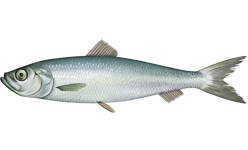
Atlantic herring is a herring in the family Clupeidae. It is one of the most abundant fish species in the world. Atlantic herrings can be found on both sides of the Atlantic Ocean, congregating in large schools. They can grow up to 45 centimetres (18 in) in length and weigh up to 1.1 kilograms (2.4 lb). They feed on copepods, krill and small fish, while their natural predators are seals, whales, cod and other larger fish.

Mycteroperca bonaci, the black grouper, black rockfish or marbled rockfish, is a species of marine ray-finned fish, a grouper from the subfamily Epinephelinae which is part of the family Serranidae, which also includes the anthias and sea basses. Other fish are sometimes called the black grouper including the similar gag grouper, the misty grouper, and the warsaw grouper. This species is found in the western Atlantic Ocean from the northeastern United States to Brazil.
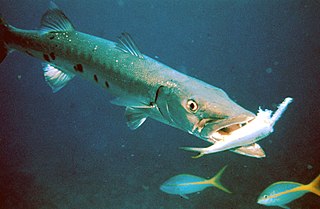
A barracuda is a large, predatory, ray-finned fish known for its fearsome appearance and ferocious behaviour. The barracuda is a saltwater fish of the genus Sphyraena, the only genus in the family Sphyraenidae, which was named by Constantine Samuel Rafinesque in 1815. It is found in tropical and subtropical oceans worldwide ranging from the eastern border of the Atlantic Ocean to the Red Sea, on its western border the Caribbean Sea, and in tropical areas of the Pacific Ocean. Barracudas reside near the top of the water and near coral reefs and sea grasses. Barracudas are targeted by sport-fishing enthusiasts.

Sebastes norvegicus, the rose fish, rock fish, ocean perch, Atlantic redfish, Norway haddock, golden redfish, pinkbelly rosefish or bergylt, is a species of marine ray-finned fish belonging to the subfamily Sebastinae, the rockfishes, part of the family Scorpaenidae. It is found in the North Atlantic Ocean. It is a large, slow-growing, late-maturing fish and the subject of a fishery.

The European sprat, also known as bristling, brisling, garvie, garvock, Russian sardine, russlet, skipper or whitebait, is a species of small marine fish in the herring family Clupeidae. Found in European waters, it has silver grey scales and white-grey flesh. Specific seas in which the species occurs include the Irish Sea, Black Sea, Baltic Sea and Sea of the Hebrides. The fish is the subject of fisheries, particularly in Scandinavia, and is made into fish meal, as well as being used for human consumption. When used for food it can be canned, salted, breaded, fried, boiled, grilled, baked, deep fried, marinated, broiled, and smoked.

The Australian herring, also known as the ruff, tommy ruff, or Australian ruff, is one of four Australasian fish species within the genus Arripis. It closely resembles its sister species, the Australian salmon, although it grows to a smaller size. Like the other members of its genus, it is found in cooler waters around the southern coast of Australia. It is not biologically related to the herring family Clupeidae.
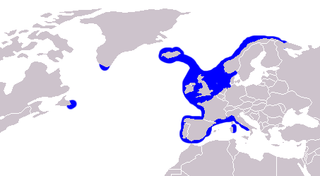
The common ling, also known as the white ling or simply the ling, is a large member of the family Lotidae, a group of cod-like fishes. It resembles the related rocklings, but it is much larger and has a single barbel. This species is unrelated to the pink ling, Genypterus blacodes, from the Southern Hemisphere. The common ling is found in the northern Atlantic, mainly off Europe, and into the Mediterranean Basin. It is an important quarry species for fisheries, especially in the northeastern Atlantic, although some doubts exist as to the sustainability of the fisheries. As an edible species, it is eaten fresh, frozen, or dried, but also preserved in lye, while the roe is a delicacy in Spain.

Sardinella is a genus of fish in the family Dorosomatidae found in the Atlantic, Indian and Pacific Ocean. They are abundant in warmer waters of the tropical and subtropical oceans. Adults are generally coastal, schooling, marine fish but juveniles are often found in lagoons and estuaries. These species are distinguished by their ranges and by specific body features, but they are often confused with one another. Fish of the genus have seven to 14 striped markings along the scales of the top of the head. The paddle-shaped supramaxilla bones are characteristic; they separate Sardinella from other genera and their shapes help distinguish species. They have paired predorsal scales and enlarged fin rays.
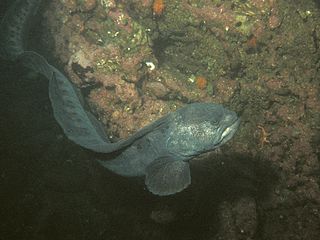
The wolf eel is a species of marine ray-finned fish belonging to the family Anarhichadidae, the wolf fishes. It is found in the North Pacific Ocean. Despite its common name and resemblance, it is not a true eel. It is the only species in the monotypic genus Anarrhichthys.
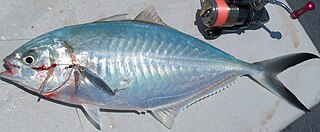
The herring scad, is a common species of tropical marine fish in the jack family Carangidae. The species inhabits the surface waters of coastal regions throughout the Indo-West Pacific region, feeding on a variety of crustaceans and small fishes. It is the largest fish of the scad genus Alepes, growing to a recorded length of 56 cm. The herring scad is identified among the genus Alepes by its more numerous and smaller scutes and the number of gill rakers on the first arch. It is of minor importance to fisheries throughout its range.

An anchovy is a small, common forage fish of the family Engraulidae. Most species are found in marine waters, but several will enter brackish water, and some in South America are restricted to fresh water.

Coastal fish, also called inshore fish or neritic fish, inhabit the sea between the shoreline and the edge of the continental shelf. Since the continental shelf is usually less than 200 metres (660 ft) deep, it follows that pelagic coastal fish are generally epipelagic fish, inhabiting the sunlit epipelagic zone. Coastal fish can be contrasted with oceanic fish or offshore fish, which inhabit the deep seas beyond the continental shelves.

The quillback rockfish, also known as the quillback seaperch, is a species of marine ray-finned fish belonging to the subfamily Sebastinae, the rockfishes, part of the family Scorpaenidae. This species primarily dwells in salt water reefs. The average adult weighs 2–7 pounds and may reach 1 m in length. Quillback rockfish are named for the sharp, venomous quills or spines on the dorsal fin. Their mottled orange-brown coloring allows them to blend in with rocky bottom reefs. The quillback rockfish eats mainly crustaceans, but will also eat herring. They are solitary and minimally migratory, but not territorial, and give birth to live young (viviparous). They are a popular sport fish, generally caught in cold water 41–60 m deep, but also to subtidal depths of 275 m.

Clupea is genus of planktivorous bony fish belonging to the family Clupeidae, commonly known as herrings. They are found in the shallow, temperate waters of the North Pacific and the North Atlantic oceans, including the Baltic Sea. Two main species of Clupea are currently recognized: the Atlantic herring and the Pacific herring, which have each been divided into subspecies. Herrings are forage fish moving in vast schools, coming in spring to the shores of Europe and America, where they form important commercial fisheries.
The dorab wolf-herring is a fish species from the genus Chirocentrus of the family Chirocentridae. It is a coastal fish, silvery below and bright blue above. It is found in both marine and brackish or estuarine waters, feeding on smaller fish and possibly crustaceans. Chirocentrus is from the Greek cheir meaning hand and kentron meaning sting. Dorab is from the Arabic language word darrab (ضرّاب) and the word is probably a corrupted form of durubb (دُرُبّ) the name for goldfish in Arabic. It has another Arabic name, lisan (لسان) which means tongue.
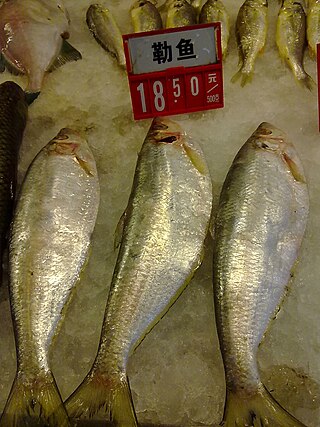
The elongate ilisha, also known as the Chinese herring or slender shad, is a species of longfin herring native to the coastal waters and estuaries of North Indian Ocean and Northwest Pacific. It is a relatively large species, up to 45–60 centimetres (18–24 in) in total length. It is an important fishery species.

Microthrissa royauxi, the royal sprat, is a species of pelagic, freshwater fish from the herring family Clupeidae which is found in the Congo River basin in west Africa. It was described in 1902 by the Belgian-British zoologist George Albert Boulenger. It is of limited importance as a food fish in subsistence fisheries and its conservation status is Least Concern.


















